seats KIA CARENS RHD 2018 Owners Manual
[x] Cancel search | Manufacturer: KIA, Model Year: 2018, Model line: CARENS RHD, Model: KIA CARENS RHD 2018Pages: 723, PDF Size: 40.94 MB
Page 21 of 723
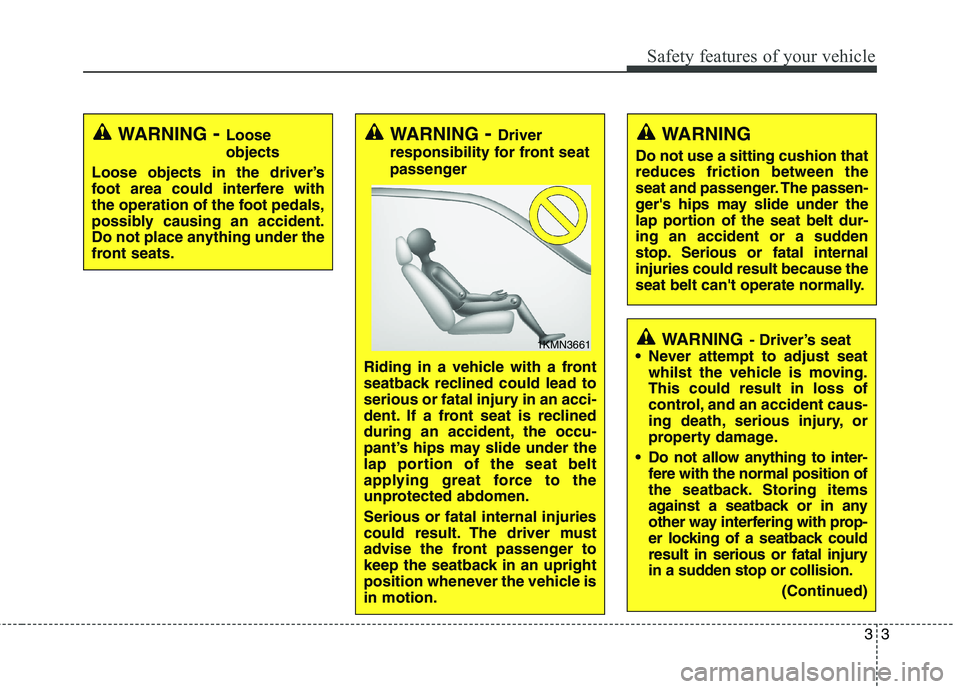
33
Safety features of your vehicle
WARNING- Loose objects
Loose objects in the driver’s
foot area could interfere with
the operation of the foot pedals,
possibly causing an accident.
Do not place anything under the
front seats.WARNING - Driver
responsibility for front seat
passenger
Riding in a vehicle with a front
seatback reclined could lead to
serious or fatal injury in an acci-
dent. If a front seat is reclined
during an accident, the occu-
pant’s hips may slide under the
lap portion of the seat belt
applying great force to the
unprotected abdomen. Serious or fatal internal injuries
could result. The driver must
advise the front passenger to
keep the seatback in an upright
position whenever the vehicle isin motion.
1KMN3661
WARNING
Do not use a sitting cushion that reduces friction between the
seat and passenger. The passen-
ger's hips may slide under the
lap portion of the seat belt dur-
ing an accident or a sudden
stop. Serious or fatal internalinjuries could result because the
seat belt can't operate normally.
WARNING - Driver’s seat
Never attempt to adjust seat whilst the vehicle is moving. This could result in loss of
control, and an accident caus-
ing death, serious injury, or
property damage.
Do not allow anything to inter- fere with the normal position of
the seatback. Storing items
against a seatback or in any
other way interfering with prop-
er locking of a seatback could
result in serious or fatal injury
in a sudden stop or collision.
(Continued)
Page 22 of 723
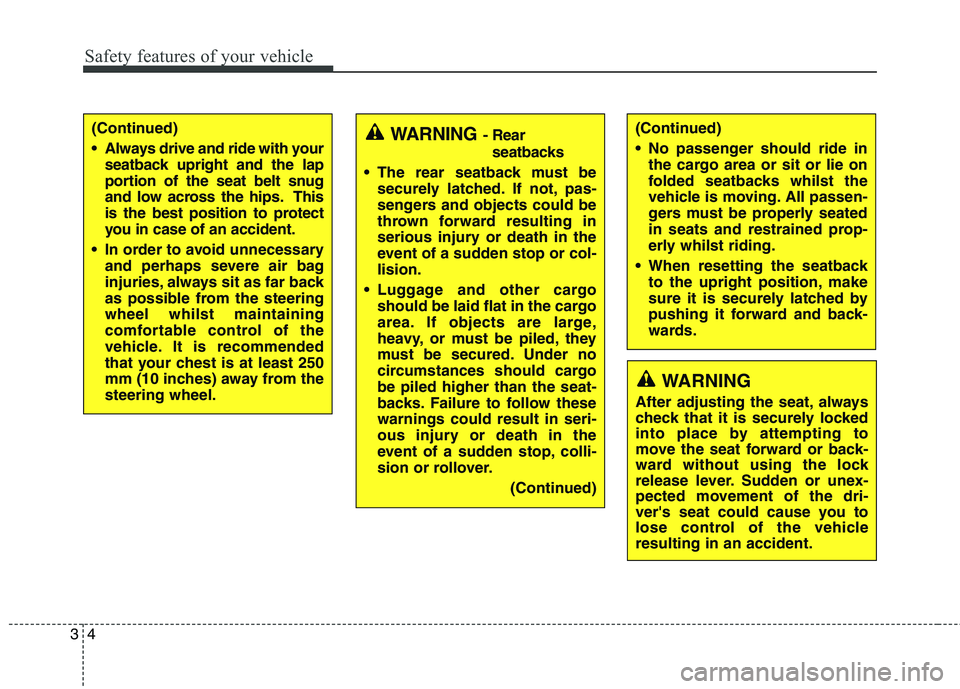
Safety features of your vehicle
4
3
(Continued)
No passenger should ride in
the cargo area or sit or lie on
folded seatbacks whilst the
vehicle is moving. All passen-
gers must be properly seated
in seats and restrained prop-
erly whilst riding.
When resetting the seatback to the upright position, make
sure it is securely latched by
pushing it forward and back-
wards.
WARNING
After adjusting the seat, always
check that it is securely locked
into place by attempting to
move the seat forward or back-
ward without using the lock
release lever. Sudden or unex-
pected movement of the dri-
ver's seat could cause you to
lose control of the vehicleresulting in an accident.
(Continued)
Always drive and ride with your seatback upright and the lap
portion of the seat belt snug
and low across the hips. This
is the best position to protect
you in case of an accident.
In order to avoid unnecessary and perhaps severe air bag
injuries, always sit as far back
as possible from the steeringwheel whilst maintaining
comfortable control of the
vehicle. It is recommended
that your chest is at least 250
mm (10 inches) away from thesteering wheel.WARNING - Rear
seatbacks
The rear seatback must be securely latched. If not, pas-
sengers and objects could be
thrown forward resulting in
serious injury or death in the
event of a sudden stop or col-lision.
Luggage and other cargo should be laid flat in the cargo
area. If objects are large,
heavy, or must be piled, they
must be secured. Under no
circumstances should cargobe piled higher than the seat-
backs. Failure to follow thesewarnings could result in seri-
ous injury or death in the
event of a sudden stop, colli-
sion or rollover.
(Continued)
Page 23 of 723
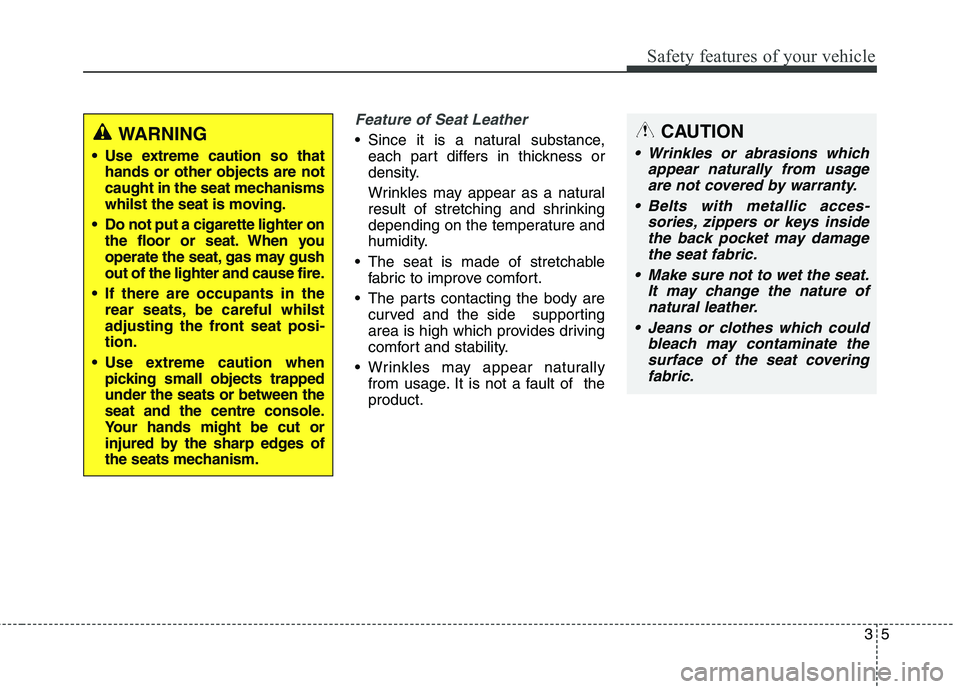
35
Safety features of your vehicle
Feature of Seat Leather
Since it is a natural substance,each part differs in thickness or
density.
Wrinkles may appear as a natural
result of stretching and shrinking
depending on the temperature and
humidity.
The seat is made of stretchable fabric to improve comfort.
The parts contacting the body are curved and the side supporting
area is high which provides driving
comfort and stability.
Wrinkles may appear naturally from usage. It is not a fault of theproduct.WARNING
Use extreme caution so that hands or other objects are not
caught in the seat mechanisms
whilst the seat is moving.
Do not put a cigarette lighter on the floor or seat. When you
operate the seat, gas may gush
out of the lighter and cause fire.
If there are occupants in the rear seats, be careful whilst
adjusting the front seat posi-tion.
Use extreme caution when picking small objects trappedunder the seats or between the
seat and the centre console.
Your hands might be cut or
injured by the sharp edges of
the seats mechanism.CAUTION
Wrinkles or abrasions which
appear naturally from usageare not covered by warranty.
Belts with metallic acces- sories, zippers or keys insidethe back pocket may damagethe seat fabric.
Make sure not to wet the seat. It may change the nature ofnatural leather.
Jeans or clothes which could bleach may contaminate thesurface of the seat coveringfabric.
Page 25 of 723
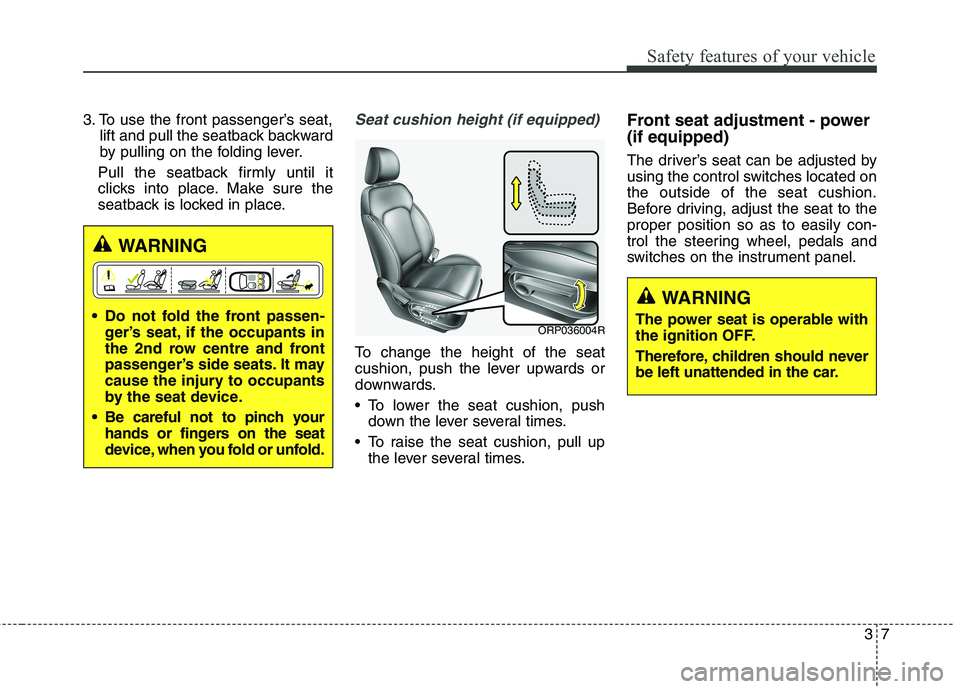
37
Safety features of your vehicle
3. To use the front passenger’s seat,lift and pull the seatback backward
by pulling on the folding lever.
Pull the seatback firmly until it
clicks into place. Make sure the
seatback is locked in place.Seat cushion height (if equipped)
To change the height of the seat
cushion, push the lever upwards or
downwards.
To lower the seat cushion, push down the lever several times.
To raise the seat cushion, pull up the lever several times. Front seat adjustment - power (if equipped)
The driver’s seat can be adjusted by
using the control switches located onthe outside of the seat cushion.
Before driving, adjust the seat to theproper position so as to easily con-
trol the steering wheel, pedals and
switches on the instrument panel.
WARNING
Do not fold the front passen- ger’s seat, if the occupants in
the 2nd row centre and front
passenger’s side seats. It may
cause the injury to occupants
by the seat device.
Be careful not to pinch your hands or fingers on the seat
device, when you fold or unfold.
ORP036004R
WARNING
The power seat is operable with
the ignition OFF.
Therefore, children should never
be left unattended in the car.
Page 28 of 723
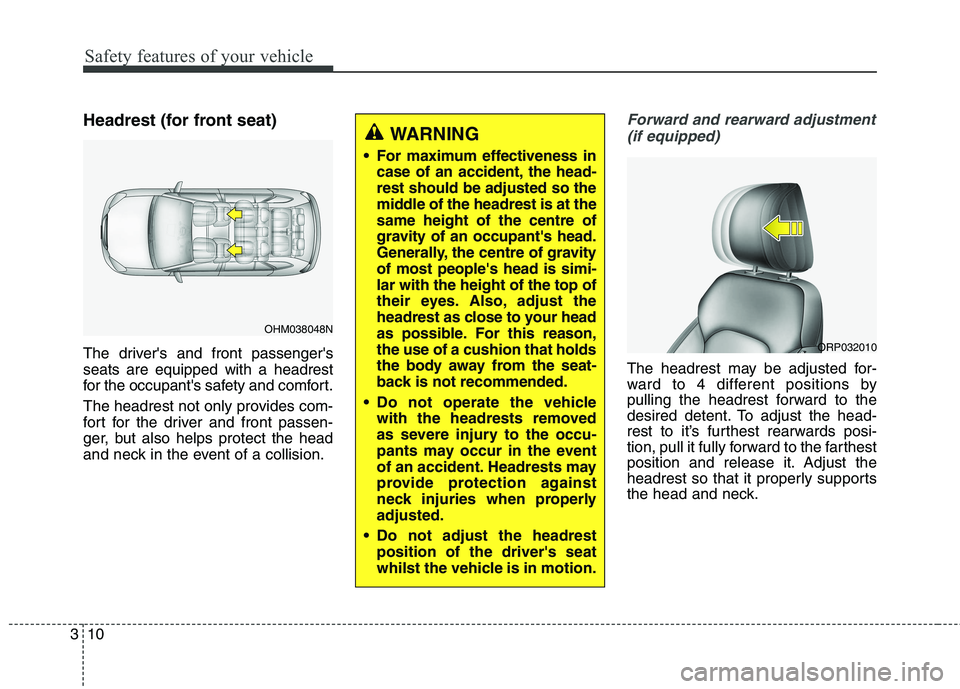
Safety features of your vehicle
10
3
Headrest (for front seat)
The driver's and front passenger's seats are equipped with a headrest
for the occupant's safety and comfort.
The headrest not only provides com-
fort for the driver and front passen-
ger, but also helps protect the head
and neck in the event of a collision.Forward and rearward adjustment
(if equipped)
The headrest may be adjusted for-
ward to 4 different positions by
pulling the headrest forward to the
desired detent. To adjust the head-
rest to it’s furthest rearwards posi-
tion, pull it fully forward to the farthest
position and release it. Adjust the
headrest so that it properly supports
the head and neck.
OHM038048N
WARNING
For maximum effectiveness in case of an accident, the head- rest should be adjusted so the
middle of the headrest is at thesame height of the centre of
gravity of an occupant's head.
Generally, the centre of gravityof most people's head is simi-lar with the height of the top of
their eyes. Also, adjust the
headrest as close to your head
as possible. For this reason,the use of a cushion that holds
the body away from the seat-
back is not recommended.
Do not operate the vehicle with the headrests removed
as severe injury to the occu-
pants may occur in the event
of an accident. Headrests may
provide protection against
neck injuries when properlyadjusted.
Do not adjust the headrest position of the driver's seat
whilst the vehicle is in motion.
ORP032010
Page 36 of 723

Safety features of your vehicle
18
3
To fold down the rear centre seat-
back (for 2nd row seat, if equipped)
1. Lower the rear headrests to the lowest position.
2. Pull the centre seatback folding lever up, then fold the seat toward
the front of the vehicle.
When you return the seatback to its
upright position, always be sure it
has locked into position by pushing
on the top of the seatback.
ORP032016
WARNING - 2nd row cen-
tre seat folding (if equipped)
Do not fold the 2nd row centre seat, if the occupants in the
3rd row seats, It may cause the
injury to occupants by the seat
device. If occupants in the 3rd
row seats, Fix the upright posi-
tion of the 2nd row centre seat.
If you use the 2nd row centre seat back folding function to
carry long objects, you should
fix the long object to prevent it
from being thrown about the
vehicle in a collision and caus-
ing injury to vehicle occupants.WARNING - Uprighting seat
When you return the seatback
to its upright position, hold the
seatback and return it slowly. If
the seatback is returned with-
out holding it, the back of the
seat could spring forward
resulting in injury caused by
being struck by the seatback.
Page 37 of 723
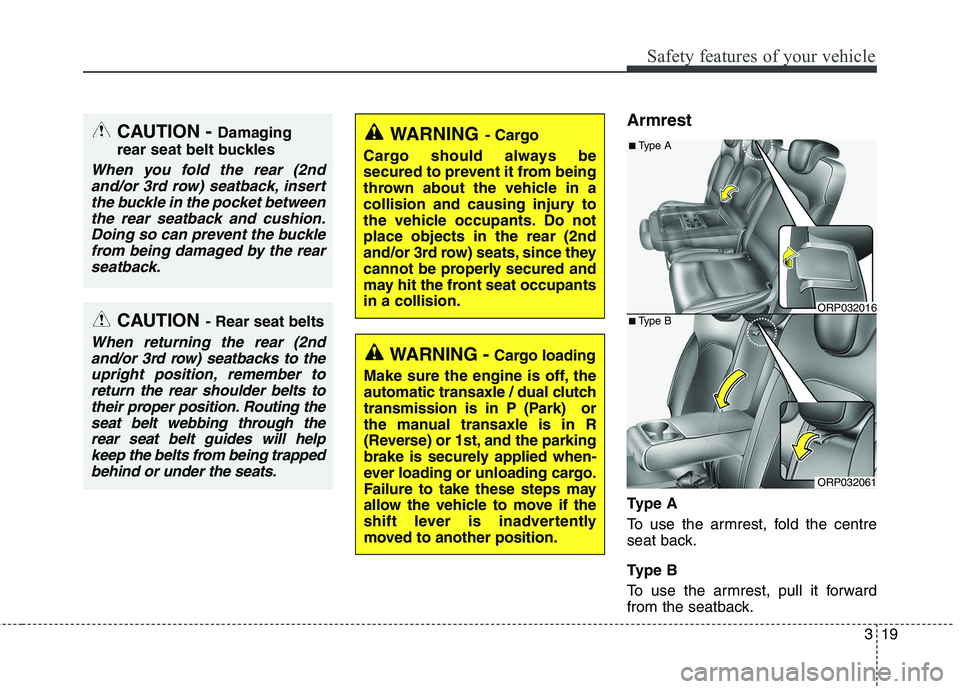
319
Safety features of your vehicle
Armrest
Ty p e A
To use the armrest, fold the centre
seat back.
Ty p e B
To use the armrest, pull it forward
from the seatback.
CAUTION- Rear seat belts
When returning the rear (2nd
and/or 3rd row) seatbacks to theupright position, remember to return the rear shoulder belts totheir proper position. Routing theseat belt webbing through the rear seat belt guides will helpkeep the belts from being trappedbehind or under the seats.
CAUTION - Damaging
rear seat belt buckles
When you fold the rear (2nd and/or 3rd row) seatback, insertthe buckle in the pocket between the rear seatback and cushion.Doing so can prevent the bucklefrom being damaged by the rear seatback.
WARNING - Cargo
Cargo should always be
secured to prevent it from being
thrown about the vehicle in a
collision and causing injury to
the vehicle occupants. Do notplace objects in the rear (2nd
and/or 3rd row) seats, since they
cannot be properly secured and
may hit the front seat occupantsin a collision.
WARNING - Cargo loading
Make sure the engine is off, the
automatic transaxle / dual clutch
transmission is in P (Park) or
the manual transaxle is in R
(Reverse) or 1st, and the parking
brake is securely applied when-
ever loading or unloading cargo.
Failure to take these steps may
allow the vehicle to move if the
shift lever is inadvertently
moved to another position.
ORP032061
ORP032016
■ Type A
■Type B
Page 38 of 723
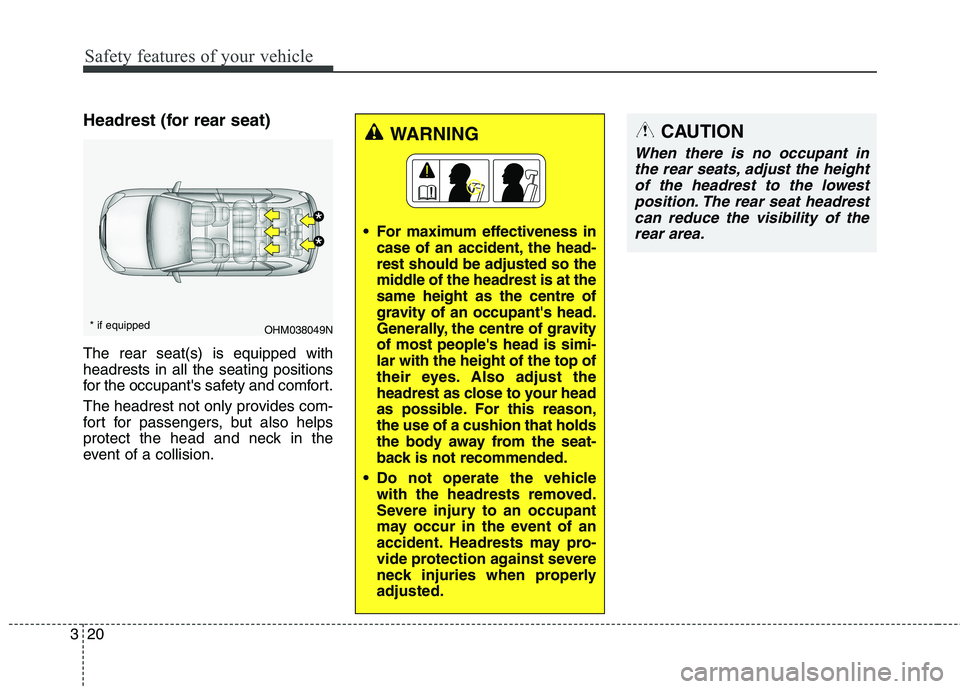
Safety features of your vehicle
20
3
Headrest (for rear seat) The rear seat(s) is equipped with headrests in all the seating positions
for the occupant's safety and comfort.
The headrest not only provides com-
fort for passengers, but also helps
protect the head and neck in the
event of a collision.
OHM038049N
*
*
* if equipped
WARNING
For maximum effectiveness in case of an accident, the head- rest should be adjusted so the
middle of the headrest is at thesame height as the centre of
gravity of an occupant's head.
Generally, the centre of gravityof most people's head is simi-lar with the height of the top of
their eyes. Also adjust the
headrest as close to your head
as possible. For this reason,the use of a cushion that holds
the body away from the seat-
back is not recommended.
Do not operate the vehicle with the headrests removed.
Severe injury to an occupant
may occur in the event of an
accident. Headrests may pro-
vide protection against severe
neck injuries when properlyadjusted.CAUTION
When there is no occupant in
the rear seats, adjust the heightof the headrest to the lowest position. The rear seat headrestcan reduce the visibility of therear area.
Page 53 of 723
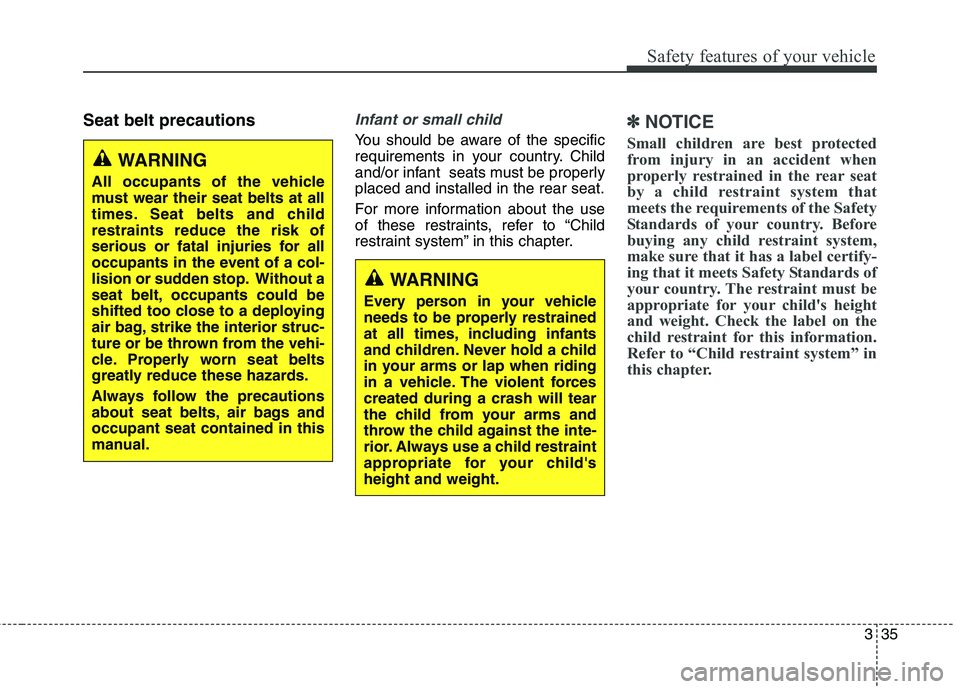
335
Safety features of your vehicle
Seat belt precautionsInfant or small child
You should be aware of the specific
requirements in your country. Child
and/or infant seats must be properlyplaced and installed in the rear seat.
For more information about the use
of these restraints, refer to “Child
restraint system” in this chapter.
✽✽NOTICE
Small children are best protected
from injury in an accident when
properly restrained in the rear seat
by a child restraint system that
meets the requirements of the Safety
Standards of your country. Before
buying any child restraint system,
make sure that it has a label certify-
ing that it meets Safety Standards of
your country. The restraint must be
appropriate for your child's height
and weight. Check the label on the
child restraint for this information.
Refer to “Child restraint system” in
this chapter.
WARNING
All occupants of the vehicle
must wear their seat belts at all
times. Seat belts and childrestraints reduce the risk of
serious or fatal injuries for all
occupants in the event of a col-
lision or sudden stop. Without a
seat belt, occupants could be
shifted too close to a deploying
air bag, strike the interior struc-
ture or be thrown from the vehi-
cle. Properly worn seat belts
greatly reduce these hazards.
Always follow the precautions
about seat belts, air bags andoccupant seat contained in this
manual.
WARNING
Every person in your vehicle
needs to be properly restrained
at all times, including infants
and children. Never hold a child
in your arms or lap when riding
in a vehicle. The violent forcescreated during a crash will tear
the child from your arms and
throw the child against the inte-
rior. Always use a child restraint
appropriate for your child'sheight and weight.
Page 55 of 723
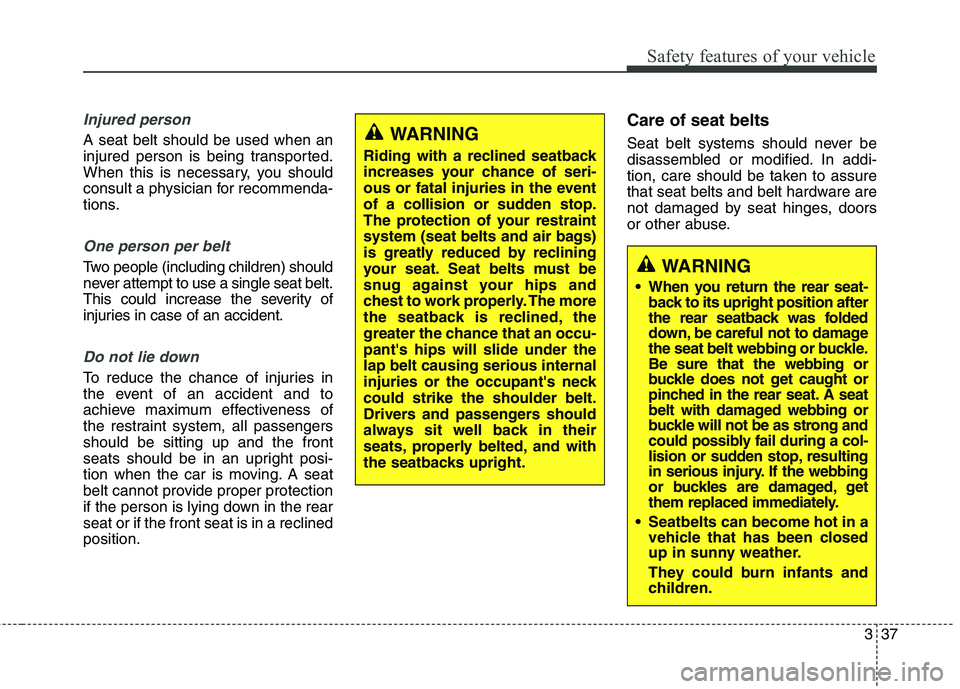
337
Safety features of your vehicle
Injured person
A seat belt should be used when an
injured person is being transported.
When this is necessary, you should
consult a physician for recommenda-
tions.
One person per belt
Two people (including children) should
never attempt to use a single seat belt.
This could increase the severity of
injuries in case of an accident.
Do not lie down
To reduce the chance of injuries in
the event of an accident and to
achieve maximum effectiveness of
the restraint system, all passengersshould be sitting up and the front
seats should be in an upright posi-
tion when the car is moving. A seat
belt cannot provide proper protection
if the person is lying down in the rearseat or if the front seat is in a reclinedposition.Care of seat belts
Seat belt systems should never be
disassembled or modified. In addi-
tion, care should be taken to assure
that seat belts and belt hardware are
not damaged by seat hinges, doors
or other abuse.
WARNING
Riding with a reclined seatback
increases your chance of seri-
ous or fatal injuries in the event
of a collision or sudden stop.
The protection of your restraint
system (seat belts and air bags)
is greatly reduced by reclining
your seat. Seat belts must be
snug against your hips and
chest to work properly. The more
the seatback is reclined, the
greater the chance that an occu-pant's hips will slide under thelap belt causing serious internal
injuries or the occupant's neckcould strike the shoulder belt.
Drivers and passengers should
always sit well back in their
seats, properly belted, and with
the seatbacks upright.
WARNING
When you return the rear seat- back to its upright position after
the rear seatback was folded
down, be careful not to damage
the seat belt webbing or buckle.Be sure that the webbing or
buckle does not get caught or
pinched in the rear seat. A seat
belt with damaged webbing or
buckle will not be as strong and
could possibly fail during a col-
lision or sudden stop, resulting
in serious injury. If the webbing
or buckles are damaged, get
them replaced immediately.
Seatbelts can become hot in a vehicle that has been closed
up in sunny weather.
They could burn infants and
children.